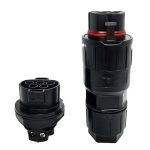Connectors play a crucial role in any electronic application. They serve as a bridge between different components and enable the transfer of data, power, and signals. Choosing the right connector for your application is essential to ensure proper functionality, reliability, and safety. In this article, we will compare two popular connectors – the GX12 and GX16 – to help you determine which one is suitable for your application.
Technical Specifications
Before comparing the GX12 and GX16 connectors, let’s take a closer look at their technical specifications.
GX12 Connector
The GX12 connector is a circular connector with a diameter of 12mm. It features a push-pull locking mechanism and is available in various contact arrangements ranging from 2 to 12 pins. The GX12 connector has a voltage rating of 250V and a current rating of 5A. It also has an IP rating of IP65, which means it is dust-tight and protected against water jets.
GX16 Connector
The GX16 connector, on the other hand, is also a circular connector but with a diameter of 16mm. It features a threaded locking mechanism and is available in contact arrangements ranging from 2 to 20 pins. The GX16 connector has a voltage rating of 400V and a current rating of 5A. It also has an IP rating of IP67, which means it is dust-tight and can withstand temporary immersion in water.
Comparison of GX12 and GX16 Connectors
Now that we know the technical specifications of the GX12 and GX16 connectors, let’s compare them in detail.
Size Comparison
The most noticeable difference between the GX12 and GX16 connectors is their size. The GX12 connector has a diameter of 12mm, while the GX16 connector has a diameter of 16mm. The GX16 connector is also longer than the GX12 connector. Therefore, if space is a concern, the GX12 connector may be a better option.
Contact Arrangement Comparison
Both the GX12 and GX16 connectors are available in various contact arrangements, but the GX16 connector has a wider range of options. The GX12 connector is available in contact arrangements ranging from 2 to 12 pins, while the GX16 connector is available in contact arrangements ranging from 2 to 20 pins. Therefore, if you need more pins for your application, the GX16 connector may be a better option.
Voltage Rating Comparison
The GX16 connector has a higher voltage rating of 400V compared to the GX12 connector’s 250V rating. Therefore, if you need to handle higher voltages, the GX16 connector may be a better option.
Current Rating Comparison
Both the GX12 and GX16 connectors have the same current rating of 5A. Therefore, if your application requires a current rating of 5A or less, both connectors will work equally well.
IP Rating Comparison
The GX16 connector has a higher IP rating of IP67 compared to the GX12 connector’s IP65 rating. Therefore, if your application requires a higher degree of protection against water, the GX16 connector may be a better option.
Application Comparison
Both the GX12 and GX16 connectors are suitable for various applications, but their specific uses differ. The GX12 connector is commonly used in the aerospace and defense industry, medical equipment, and industrial automation. The GX16 connector, on the other hand, is commonly used in marine equipment, audio equipment, and power supply applications.
Advantages and Disadvantages
Both the GX12 and GX16 connectors have their advantages and disadvantages. Let’s take a closer look at them.
GX12 Advantages
- Smaller size
- Push-pull locking mechanism is easier to use in tight spaces.
- Available in a variety of contact arrangements.
- Suitable for applications that require a lower voltage rating.
GX12 Disadvantages
- Lower IP rating compared to the GX16 connector.
- Limited contact arrangements compared to the GX16 connector.
- Not suitable for applications that require a higher voltage rating.
GX16 Advantages
- Larger size allows for more contact arrangements.
- Threaded locking mechanism provides a more secure connection.
- Higher voltage rating compared to the GX12 connector.
- Higher IP rating compared to the GX12 connector.
GX16 Disadvantages
- Larger size may not be suitable for applications with limited space.
- Threaded locking mechanism can be difficult to use in tight spaces.
- Limited availability of contact arrangements above 12 pins.
Conclusion
In conclusion, the choice between the GX12 and GX16 connector depends on your specific application requirements. The GX12 connector is a better option if you need a smaller connector with a lower voltage rating and a push-pull locking mechanism. On the other hand, the GX16 connector is a better option if you need a larger connector with a higher voltage rating and a threaded locking mechanism.
It’s important to remember that both connectors have their advantages and disadvantages, and the final decision should be based on your specific application needs. We hope this article has helped you understand the differences between the GX12 and GX16 connectors and has helped you make an informed decision for your next project.



